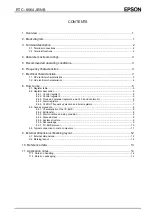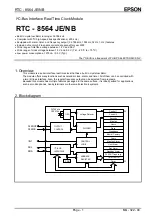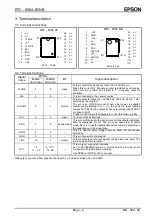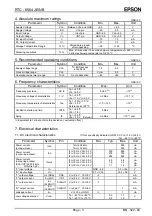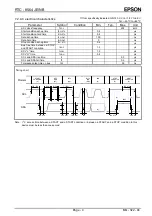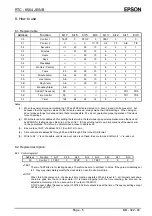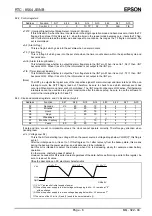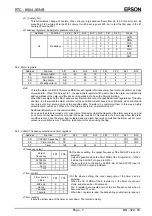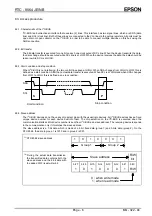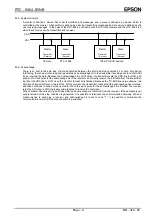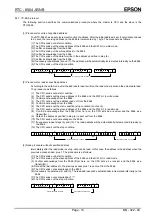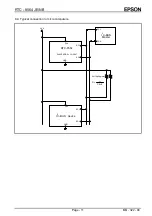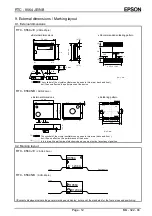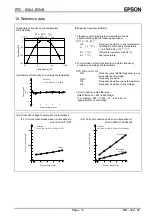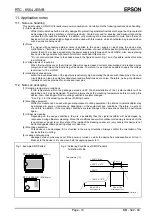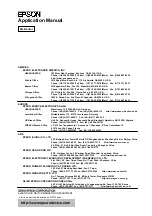
RTC - 8564 JE/NB
Page - 14
MQ - 322 - 04
11. Application notes
11.1. Notes on handling
This module uses a C-MOS IC to realize low power consumption. Carefully note the following cautions when handling.
(1) Static electricity
While this module has built-in circuitry designed to protect it against electrostatic discharge, the chip could still
be damaged by a large discharge of static electricity. Containers used for packing and transport should be
constructed of conductive materials. In addition, only soldering irons, measurement circuits, and other such
devices which do not leak high voltage should be used with this module, which should also be grounded when
such devices are being used.
(2) Noise
If a signal with excessive external noise is applied to the power supply or input pins, the device may
malfunction or "latch up." In order to ensure stable operation, connect a filter capacitor (preferably ceramic) of
greater that 0.1F as close as possible to the power supply pins (between V
DD
and GNDs). Also, avoid placing
any device that generates high level of electronic noise near this module.
* Do not connect signal lines to the shaded area in the figure shown in Fig. 1 and, if possible, embed this area
in a GND land.
(3) Voltage levels of input pins
When the input pins are at the mid-level, this will cause increased current consumption and a reduced noise
margin, and can impair the functioning of the device. Therefore, try as much as possible to apply the voltage
level close to V
DD
or GND.
(4) Handling of unused pins
Since the input impedance of the input pins is extremely high, operating the device with these pins in the open
circuit state can lead to unstable voltage level and malfunctions due to noise. Therefore, pull-up or pull-down
resistors should be provided for all unused input pins.
11.2. Notes on packaging
(1) Soldering temperature conditions
If the temperature within the package e260, the characteristics of the crystal oscillator will be
degraded and it may be damaged. Therefore, always check the mounting temperature before mounting this
device. Also, check again if the mounting conditions are later changed.
* See Fig. 2 for the soldering conditions of SMD products.
(2) Mounting equipment
While this module can be used with general-purpose mounting equipment, the internal crystal oscillator may
be damaged in some circumstances, depending on the equipment and conditions. Therefore, be sure to
check this. In addition, if the mounting conditions are later changed, the same check should be performed
again.
(3) Ultrasonic cleaning
Depending on the usage conditions, there is a possibility that the crystal oscillator will be damaged by
resonance during ultrasonic cleaning. Since the conditions under which ultrasonic cleaning is carried out (the
type of cleaner, power level, time, state of the inside of the cleaning vessel, etc.) vary widely, this device is not
warranted against damage during ultrasonic cleaning.
(4) Mounting orientation
This device can be damaged if it is mounted in the wrong orientation. Always confirm the orientation of the
device before mounting.
(5) Leakage between pins
Leakage between pins may occur if the power is turned on while the device has condensation or dirt on it.
Make sure the device is dry and clean before supplying power to it.
Fig. 1: Example GND Pattern
Fig. 2: Soldering Conditions of SMD Products
Air Reflow Profile
RTC - 8564 JE
( VSOJ-20pin )
RTC - 8564 NB
( SON-22pin )
90 s
±
30 s
Pre-heating area
time [ s ]
Temperature [
°
C ]
+150
°
C
±
10
°
C
+200
°
C
+240
°
C
Max.
+235
°
C
±
5
°
C
10 s
±
1 s
30 s
±
10 s
Stable Melting area

